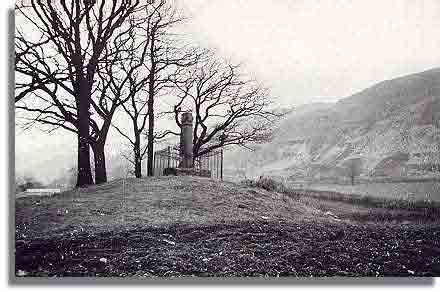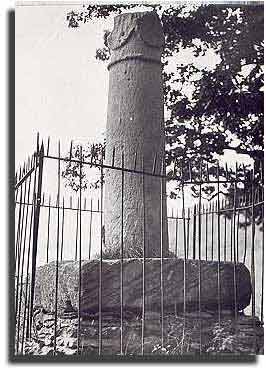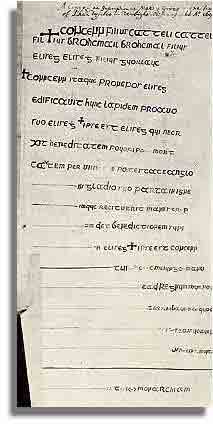Vortigern
Studies Index










|
|

click here
|
The text of the Pillar of
Eliseg
Robert
Vermaat |
 The Pillar of Eliseg (or Elise or
Eliset) is of very great interest to the study of
Vortigern. Although none of its inscription can now be
read, the possibility exists that this monument contains
unique information about Vortigern and his family. The
shaft bears an elaborate Latin inscription, which has
weathered away and is now illegible to an unpractised
eye. On the opposing face is a later inscription, also in
Latin, recording the restoration of the monument in 1779.
Luckily, considerable portions of the original
inscription were read by the antiquarian Edward Llwyd in
1696; and his transcript seems to have been remarkably
accurate. With the help of this, much of the surviving
text of the original The Pillar of Eliseg (or Elise or
Eliset) is of very great interest to the study of
Vortigern. Although none of its inscription can now be
read, the possibility exists that this monument contains
unique information about Vortigern and his family. The
shaft bears an elaborate Latin inscription, which has
weathered away and is now illegible to an unpractised
eye. On the opposing face is a later inscription, also in
Latin, recording the restoration of the monument in 1779.
Luckily, considerable portions of the original
inscription were read by the antiquarian Edward Llwyd in
1696; and his transcript seems to have been remarkably
accurate. With the help of this, much of the surviving
text of the original  31 lines is recoverable. And just
in time, judging from the comment of sevral experts:
Westwood (1879) states that the word `Cattell' is `almost
the only word now legible'. Macalister (1949) states,
`The decipherment would probably now be beyond hope had
it not been for Lhuyd's copy, made in 1696'.
Nash-Williams (1950) says that the `Inscription is now
mostly weathered away'. Redknap (1991), describes it as
`now worn and incomplete'. 31 lines is recoverable. And just
in time, judging from the comment of sevral experts:
Westwood (1879) states that the word `Cattell' is `almost
the only word now legible'. Macalister (1949) states,
`The decipherment would probably now be beyond hope had
it not been for Lhuyd's copy, made in 1696'.
Nash-Williams (1950) says that the `Inscription is now
mostly weathered away'. Redknap (1991), describes it as
`now worn and incomplete'.
The small crosses
interspaced in the inscription serve to break it up into
paragraphs, the first two giving the the genealogy of
Concenn and Eliseg. The third paragraph is incomplete,
but seems to record the exploits of Eliseg and the
enlargement of his kingdom, whether with the help or at
the expense of the English. The next paragraph seems to
summarize the achievements of Concenn himself, followed
by a glorifying of the dynasty by reference of their
ancestors, the Roman Emperor Magnus Maximus and
Vortigern.
Dating
The earliest dating is
by Macalister, who in 1928 dated the Pillar to Ad 708-99.
Nash-Williams, in 1950, dated the monument between
800-25, which is still the accepted date. This dating has
consequences for the trustworthiness of this text and its
implications for Vortigern, his family and the dynasty of
Powys. The trustworthiness will be discussed elsewhere, in the article about the Pillar
of Elise itself.
Names
Below are the personal
names (PN) found within the text:
- Concenn
(Language: Brittonic; Gender: male)
In general on the genealogy on Eliseg's pillar
see Bartrum/1966, 46. Macalister/1949, 147,
`Concenn is apparently the Cyngen (Brut), or
Cinnen (A.C.) king of Powys, who died in Rome
A.D. 854'.
Nash-Williams/1950, 124, `Concenn was the last of
the line, dying after a long reign, in Rome,
whither he had gone on pilgrimage, in or about
854'.
- Cattell
(Language: Brittonic; Gender: male)
Macalister/1949, 147: `Catell rex Pouis died in
808 A.D. according to Annales Cambriae'.
Nash-Williams/1950, 124: `Cattell, mentioned in
l. 1, is generally accepted as the king of that
name who died in 808'.
- Brochmail
(Language: Brittonic; Gender: male)
Macalister/1949, 146-147, states that
`Brochmael...[does not] appear in the annalistic
history', he does however record the Harleian
genealogy which places `Brocmayl' as the father
of Catel who was father of Cincen.
- Eliseg
(Language: Brittonic; Gender: male)
Nash-Williams/1950, 124: `Eliseg (or Eliset), in
whose honour the present monument was erected,
represented the tenth generation of the dynasty
and apparently flourished in the middle of the
8th century'.
Davies/1982, 110: `In the middle of the ninth
century Cyngen of Powys could still remember that
his great-grand-father Elise had annexed land for
Powys away from the power of the English'.
- Guoillauc
(Language: Brittonic; Gender: male)
Macalister/1949, 146-147, records that this name
is recorded in the Harleian genealogies as that
of the father of Eliseg, he also states that the
name does not appear in the annals.
- Maximus
(Language: Latin; Gender: male)
Macalister/1949, 149: `This Maximus was the
usurper who rebelled against Gratian...and was
himself put to death by Theodosius'.
Nash-Williams/1950, 124: `the Roman Emperor
Magnus Maximus, the `Maxen Wledig' of Welsh
tradition'.
- [Cina]nn
(Language: Brittonic; Gender: male)
- Pascen[t]
(Language: Latin; Gender: male)
- [Maucant]
(Language: Brittonic; Gender: male)
Harleian 3859.22 and 27 give Maucant the place of
son of Pascent, while the Pillar makes him the
latter's father.
- Britu
(Language: Brittonic; Gender: male)
The text itself identifies Britu as the son of
Vortigern and Severa the daughter of Magnus
Maximus. The text also states that Britu was
blessed by Germanus of Auxerre, although it may
be possible that it was Vortigern who was blessed
here. See note [12].
- Guarthi[gern]
(Language: Brittonic; Gender: male)
Nash-Williams/1950, 124: `King Vortigern'. This
is the Vortigern of Bede's Ecclesiastical
History, the `superbus tyrannus' of Gildas.
Truthfully, it should be mentioned that it is
possible that not Vortigern is mentioned here,
but Vortimer. However, I hold that for next to
impossible, because Vortimer has no function in
any legend apart from his short stint as defender
of Britain. He is non-existant in pedigrees. See
also note [12].
- Germanus
(Language: Latin; Gender: male)
This is not Germanus of Auxerre,
although the identification has been made through
contemporary (with the Pillar) legends, who
needed to make a link between early saints and
later foundations. the germanus of the legends is
most probably Garmon of Man, who was the founder
of many churches in Wales.
- Severa
(Language: Latin; Gender: female)
The text uniquely identifies Severa as the
daughter of Magnus Maximus and the wife of
Vortigern. She is not mentioned anywhere else,
neither in annals, nor in pedigrees, nor in later
myths. The name is perfectly normal Latin, which
does a lot for the acceptance of this
information. More about Sevire here.
- Conmarch
(Language: Brittonic; Gender: male)
The text

This is
a detail of part of the text recovered by Edward Llwyd in
1696: lines 1 - 14.
Below I have printed the
text on the Pillar of Elise. In the left column the
expanded text by Nash-Williams (1950) and the middle
column being his version of the translation, with notes
to where it differs from the former, as well as
Macalister (1949), Bartrum (1966) and Howlett (1998).
 
This
is how the transcript of the text appears today on the
MS.
| Pillar of
Elise |
|
Colofon Elise |
| _________________ +
Concenn son of Catell, Catell
|
|
_________________ +
CONCENN FILIUS CATTELL CATTELL
|
son of
Brochmael, Brochmael son of
|
|
FILIUS BROHCMAIL
BROHCMAIL FILIUS |
Eliseg,
Eliseg son of Guoillauc.
|
|
ELISEG ELISEG FILIUS
GUOLLAUC |
+
Concenn, therefore being great-grandson of
Eliseg,
|
|
+
CONCENN ITAQUE PRONEPOS ELISEG |
erected
this stone to his great-grandfather
|
|
EDIFICAUIT HUNC LAPIEM
PRO AUO[1] |
Eliseg.
+ It is Eliseg who
|
|
SUO ELISEG +
IPSE EST ELISEG QUI NEC[.] |
annexed
the inheritance of Powys [--]
|
|
XIT HEREDITATEM POUOIS[--] |
throughout
nine (years?) from the power of the Engl
|
|
PER VIIII [ANNOS.]E
POTESTATE ANGLO[2] |
ish
which he made into a sword-land by fire
|
|
RUM IN GLADIO SUO
PARTA IN IGNE |
+
Whosoever shall read this hand-inscribed stone,
|
|
[+ QUIC]UMQUE RECIT[A]UERIT
MANESCRIP |
let
him give a blessing on
|
|
[TUM LAPID]EM DET
BENEDICTIONEM SUPE |
the
soul of Eliseg + It is
Concenn who ...
|
|
[R ANIMA]M ELISEG +
IPSE EST CONCENN |
...
with his hand
|
|
[--]GMANU [--] |
.. to
his own kingdom of Powys
|
|
[--] AD REGNUM SUUM
POUOIS |
.. and
which
|
|
[--] [4] ET QUOD [5] |
[--]
the mountain
|
|
[--] [6]MONTEM [7] |
(one
line lost, possibly more) [8]
|
|
[--] |
[--]
the Monarchy
|
|
[--] MONARCHIAM |
Maximus
of Britain
|
|
[--] [9]MAXIMUS BRITTANNIAE [10] |
| Concenn, Pascent ...
Maun, Annan. |
|
[CONCE]NN
PASCEN[T] MAUN ANNAN[11] |
| Britu moreover son of
Guarthi |
|
[+]
BRITU A[U]T[E]M FILIUS GUARTHI |
| gern, whom Germanus
blessed |
|
[GIRN] QUE[M]
BENED[IXIT] GERMANUS[12] QUE[M] |
| and whom Severa, bore to
him, the daughter of Maximus the King, |
|
[QU]E PEPERIT EI SE[V]IRA
FILIA MAXIMI R |
| who slew the king of the
Roman |
|
[E]GIS QUI OCCIDIT
REGEM ROMANO |
| s. + Conmarch
painted this |
|
RUM + CONMARCH
PINXIT HOC |
| writing at the command of
his king |
|
CHIROGRAFIUM [13] REGE SUO POSCENTE |
| Concenn. +
The blessing of the Lord (be) on Con |
|
CONCENN +
BENEDICTIO DOMINI IN CON |
| cenn and all members of
his family |
|
CENN ET SUOS IN TOTA
FAMILIA EIUS |
| and upon all the land of
Powys |
|
ET IN TOTAM [RE]GIONEM
POUOIS |
| until the Day of
Judgement. Amen. |
|
USQUE IN [DIEM
IUDICII AMEN][14] |
Notes
[1] Another translation could be 'ancestor'.
[2] Macalister and Howlett have: EX MAN[U]
CAT(...)EM PER U, ("from the hand of Cat(...)em
through [--]") I have as another possibility: ...PO(st)
MORT(em) CA(u?)TEM, translated with "after the death of.. Ca(u)tem"
[3] Nash-Williams seems to leave out a lot
here. Macalister has: + IPSE EST CONCENN [QUI NACTUS
ESTMC IUN]G MANU SUA QUAE AD REGNUM SU]UM PUOIS
("This is Concenn(PN) who captures 1100 acres by his
hand which used to belong to the kingdom of Powys"),
while Howlett has: + IPSE EST CONCENN QUI NACTUS EST MC
IUNGERA MAN U SUA QUE AD REGNUM SUUM POUOIS
("Concenn(PN) is the very one who attached 1100
yokes with his own hand which to his own kingdom of Powys
formerly belonged").
[4] Again, much conservatism by
Nash-Williams. Others see much more, but manage no better
translation. Macalister has: "[--] [P]ERTIN[E]BANT
ET APUD [--] SEAISNCANESINEC [--]ISR[..] EM [..]
("and in"), while Howlett has: "OLIM
PERTINEBANT ET APUD [--]SE [.]AISNCANESINEC
[--]ISR[--]EM[--] ("[--] and in his presence").
[5] I can discern the letters:
...ER(?)NBANI..S.. This is an illegible part, ignored by
all.
[6] It may be illegible, but this could be:
.??//??AIFUCAUESIM
[7] More letters here: .I.P..EIN
(illegible)?...
[8] One line lost, possibly more, but ignored
by Nash-Williams and the others.
[9] Macalister and Howlett definately read
the end of a name here, before Maximus: ...AIL.
[10] Howlett translates MAXIMUS BRITTANNIAE
with "greatest of Britain".
[11] Macalister has: "[--]NN PASCEN[--]
MAUN ANNAN", meaning"[son of Cina]nn(PN).
Pascen[t](PN) son of Maucant(PN)?] [--] ". I think
that the usual rendering as Maun, Annan, could indeed be
a mistake for Maucant. This Maucant would then have been
the son of Britu and grandson of Vortigern.
Interestingly, the Harleian pedigrees give a Maucant, but
as son of Pascent rather than his father. A later form is
Manogan.
[12] According to the Historia Brittonum,
Vortigern had three sons, AND St. Faustus. Britu must
therefore be a fifth son, or an alias of one of the other
four (read more here). We are also not sure who was
blessed by Germanus, Britu or Vortigern. Read more about
that blessing here. But as Vortimer was reputedly
blessed by Germanus, was he also to be identified with
Britu, or is he in fact the 'Guarthi[..] mentioned on the
Pillar - Guarthimir?
[13] Macalister translates CHIROGRAFUM with
"copy", Howlett with "artefact written by
hand".
[14] Macalister has "for ever",
Howlett "until eternity".
See
as well at this site: Deeds most ancient, an article by Keith Nurse.
Bibliography 
- Bartrum, P.C.: Early Welsh Genealogical
Tracts, (Cardiff 1966).*
- Bu'Lock, J.D.: Vortigern and the Pillar
of Eliseg, in: Antiquity XXXIV,1960, pp.
49-53.*
- Chadwick, N.K.: A Note on Faustus and
Riocatus, in: Chadwick, Studies in Early
British History, pp. 254-263.*
- Laing, Lloyd Robert
and Jennifer Laing: A Guide to Dark Age Remains in
Britain, (London 1979a).
- Nash-Williams,
V.E.: Early
Christian Monuments of Wales, (Cardiff, 1950).*
|

